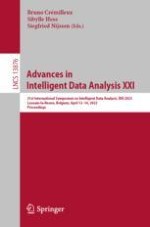2023 | Buch
Advances in Intelligent Data Analysis XXI
21st International Symposium on Intelligent Data Analysis, IDA 2023, Louvain-la-Neuve, Belgium, April 12–14, 2023, Proceedings
herausgegeben von: Bruno Crémilleux, Sibylle Hess, Siegfried Nijssen
Verlag: Springer Nature Switzerland
Buchreihe : Lecture Notes in Computer Science
